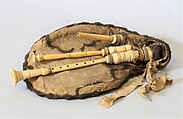‘Gaillard’ Musette
Possibly by P. Gaillard French
19th century
Not on view
This instrument is typical of the ‘Gaillard’ musettes presumably produced in the late 19th century, which all present similar features: small, mouthblown bagpipes made from ivory, with lavish textile bags. The blowpipe, melodic pipe, and parallel drone, as well as the round-headed stocks, are made entirely of ivory. The melodic pipe, parallel drone, and both stocks are adorned with a raised ring within which are cut hemispherical beads, a pattern found across many ‘Gaillard’ musettes. The double pipe stock features two rectangular indents, which may have been to secure some sort of thread across the double headed stock, as found on the Parisian cabrette. The top and the bell of the melodic pipe are marked P.G. in an oval frame, as is its stock.
The leather bag is marked ‘Gaillard’. It has a brown and beige silk cover with fine light and dark brown embroidery, featuring floral motifs. The bag is trimmed with finely woven galloon and is closed with a light-colored ribbon. Around the stock of the melodic pipes are two twisted cords, one in the same color scheme as the bagpipe, the other tricolored: blue, white, red, possibly symbolizing the French flag.
‘Gaillard’ musettes were instruments that were made for display; it is unlikely that they were played as the instruments have uneven internal bores (Libin 1997:172). They feature on late nineteenth century and early twentieth century paintings as props for romantic portraits of ladies (Montbel 2017). Despite their appearance in late nineteenth century, these objects were made to fit into a French eighteenth century aesthetic. The delicate textile bags, the elaborate trimmings and ribbons, the ivory parallel pipes, and the overall appearance of these musettes place them in the same aesthetic continuum as the baroque musette, an instrument played by the French upper class in the seventeenth and eighteenth centuries. They are intentionally confusing in terms of their dating: until Laurence Libin’s research published in 1997, many of these instruments were assumed to be from the eighteenth century, as far back as 1700. To add to this confusion, some of the textiles used for Gaillard musette covers could be from the eighteenth century, firmly placing them in a pre-revolutionary aesthetic.
These instruments were commercial products most likely made for wealthy customers with a penchant for antiquities, which included musical instrument collectors (Libin 1997:170). Instruments that feature the same aesthetic features as this musette are marked P.G. or P. Gaillard. To date, no bagpipe workshop with this name has been identified in France or Belgium. Eric Montbel suggests that Gaillard might not an instrument maker at all: this could be the stamp of an art dealer, a collector or a maker of fine objects (Montbel 2017:568). The success of this model amongst the collectors is evidenced by the presence of multiple examples of these bagpipes in Europe’s and North America’s private and museum collections (see Libin’s list 1997:176-7).
(Cassandre Balosso-Bardin, 2023)
Technical description
Faded brocade-covered brown leather bag with metallic edging and silk ribbon;
Beaded ivory sockets for headstock and blowpipe tied into bag;
2-piece ivory headstock with beaded socket ends, the two pieces partially cut down circumferentially for a missing band, the chanter piece encircled by colored decorative cord;
Insufflation pipe has leather flap valve notched into tenon;
Drone pipe of 4 separate pieces including ring at tenon (ring held on by small wood wedge beneath);
Melodic pipe of at least 3 pieces, but chanter has cork under thread; reeds missing;
Tubes maybe roughed on a lathe but hand-finished because turning is not symmetrical and bore (of drone at least) not concentric.
Marks: (stamped) "PG" in an oval (twice on chanter, once on headstock,) and signed "Gaillard" on the bag.
References
Laurence LIBIN, 1997. ‘Seeking the source of the Gaillard cornemuses’, Musique-Images-Instruments n° 3, p.168-177.
Montbel, Eric, 2017. ‘Les Musettes Gaillard des cornemuses d’ameublement’ in La Cabrette - Histoire et technique d’une cornemuse, ed. A. Ricros, E. Montbel, D. Perre. Riom: Amta, p.559- 585.
Due to rights restrictions, this image cannot be enlarged, viewed at full screen, or downloaded.
This artwork is meant to be viewed from right to left. Scroll left to view more.




